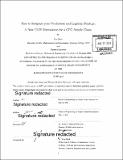| dc.contributor.advisor | Josué C. Velázquez-Martínez. | en_US |
| dc.contributor.author | Chua, Ian (Ian Hong Leong) | en_US |
| dc.contributor.author | Heyward, Thomas | en_US |
| dc.contributor.other | Massachusetts Institute of Technology. Supply Chain Management Program. | en_US |
| dc.date.accessioned | 2017-12-20T18:15:33Z | |
| dc.date.available | 2017-12-20T18:15:33Z | |
| dc.date.copyright | 2017 | en_US |
| dc.date.issued | 2017 | en_US |
| dc.identifier.uri | http://hdl.handle.net/1721.1/112871 | |
| dc.description | Thesis: M. Eng. in Supply Chain Management, Massachusetts Institute of Technology, Supply Chain Management Program, 2017. | en_US |
| dc.description | Cataloged from PDF version of thesis. | en_US |
| dc.description | Includes bibliographical references (pages 47-51). | en_US |
| dc.description.abstract | In manufacturing companies, production strategies prioritize maximizing line efficiency which favors large lot sizes and few setups. On the other hand, logistics strategies prioritize minimizing inventory costs which favors smaller lot sizes and more setups. This thesis provides a new mixed integer linear model formulation that optimizes lot sizes such that both manufacturing efficiency and inventory costs are considered simultaneously. The model solves a multi-machine capacitated lot sizing problem with novel extensions for multi-echelon inventory, transfer costs between inventory echelons, and a multi-echelon product setup hierarchy. The model includes extensions for setuptimes and multiple non-identical machine capabilities. The multi-echelon inventory extension is applicable to firms that contract a third party logistics provider's warehouse to handle seasonal inventory. In this situation, the firm has two inventory holding cost structures and desires to optimize usage of the contracted warehouse. The multi-echelon setup extension is applicable to firms that manufacture products with similar characteristics such that they share a common machine setup cost at a category or aggregated level and a unique setup cost at an item or disaggregated level. When applied to benchmarking manufacturing data, the model demonstrates improved production plans that reduce inventory and setup costs by 30% in some scenarios. This thesis emphasizes how integrating production and logistics strategies can offer significant improvement to any firm's supply chain. In particular, firms with a multi-echelon inventory or setup cost structure can benefit from a model that accounts for these important cost drivers in planning its production. | en_US |
| dc.description.statementofresponsibility | by Ian Chua and Thomas Heyward. | en_US |
| dc.format.extent | 57 pages | en_US |
| dc.language.iso | eng | en_US |
| dc.publisher | Massachusetts Institute of Technology | en_US |
| dc.rights | MIT theses may be protected by copyright. Please reuse MIT thesis content according to the MIT Libraries Permissions Policy, which is available through the URL provided. | en_US |
| dc.rights.uri | http://dspace.mit.edu/handle/1721.1/7582 | en_US |
| dc.subject | Supply Chain Management Program. | en_US |
| dc.title | How to integrate your production and logistics strategy : a new CLSP formulation for a CPG supply chain | en_US |
| dc.title.alternative | New Capacitated Lot Sizing Model formulation for a consumer packaged goods supply chain | en_US |
| dc.type | Thesis | en_US |
| dc.description.degree | M. Eng. in Supply Chain Management | en_US |
| dc.contributor.department | Massachusetts Institute of Technology. Supply Chain Management Program | |
| dc.identifier.oclc | 1014338139 | en_US |
